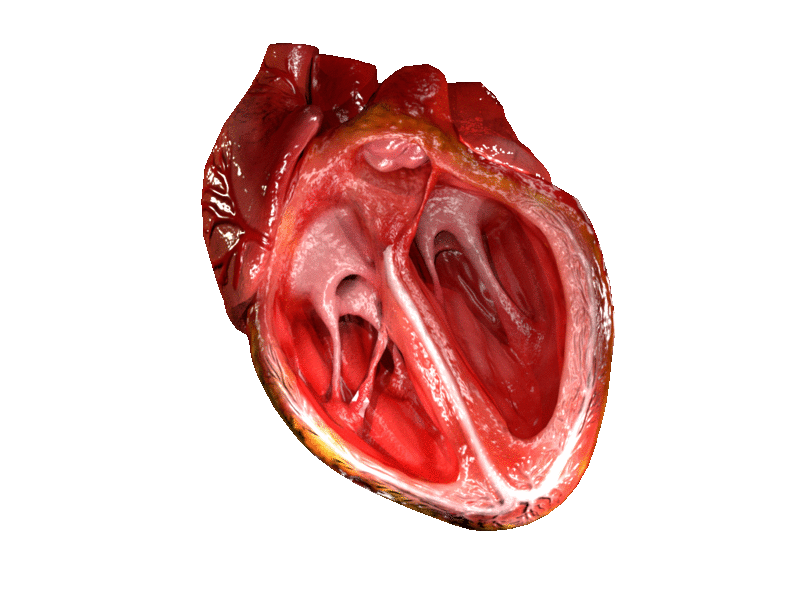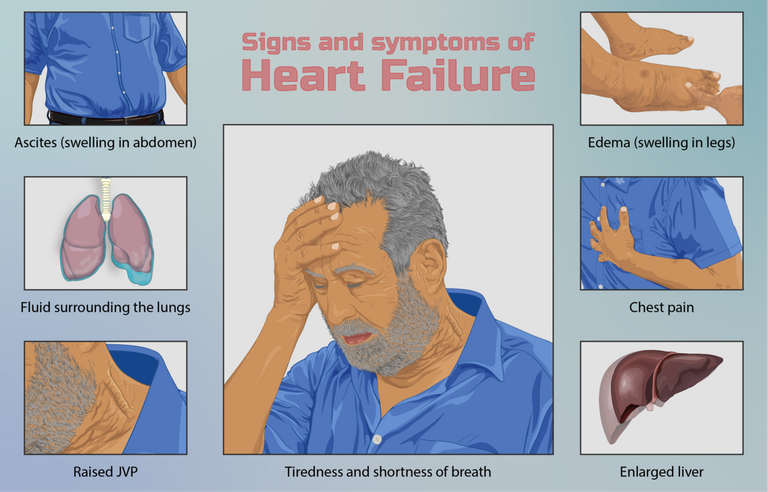
I designed this image using canva
HEART FAILURE
Heart failure can be defined as the inability of the heart to meet the body's physiological needs.
What this means in simple terms is that the heart pumps blood, but it is not enough to be used by the body for normal bodily functions. And so, it fails.
The human body is very demanding, and it needs a certain amount of blood to perform its functions. However, when it's not receiving enough blood supply, it places a demand on the heart to 'pump better'.

By Dr JanaOfficial - Official Website, Support, CC BY-SA 4.0, Wikimedia
And this further deteriorates the condition.
Heart failure is a long-term condition and worsens over time.
TYPES OF HEART FAILURE
Heart failure can either be right-sided and left-sided or systolic and diastolic.
Right and left-sided heart failure.
Right-sided heart failure: The heart is a chamber, and it is divided into the right and the left side. In right-sided heart failure, the right ventricle is affected and can't pump blood into the pulmonary artery, and the lungs in turn. Thus, there is a backflow of blood into the upper and lower extremities.
This is why you would see a person with right-sided heart failure have leg or abdominal swelling.

By Diagram of the human heart (cropped).svg, CC BY-SA 3.0, Wikimedia
Left-sided heart failure: It is called left-sided because it affects the left side of the heart. The left ventricle is either too weak or too stiff to pump blood to the aorta (which sends blood to different parts of the body).
And there is also a backflow of blood into the pulmonary vein, which causes symptoms of breathlessness and coughing.
Left sided heart failure is the most common type of heart failure.
Systolic and diastolic heart failure.
Systolic heart failure: In systolic heart failure, the heart cannot contract effective in each heartbeat.
Diastolic heart failure: The heart cannot relax between heartbeats.
CAUSES OF HEART FAILURE
Heart failure is often caused by an underlying disease.
The most common cause of heart failure is coronary heart disease (CAD). CAD is a narrowing or blockage of the coronary arteries, usually due to plaque. It blocks blood supply to the heart, and causes it to function less effectively. It may also cause chest discomfort.
Other conditions that can can cause heart failure include:
Congenital heart disease: These are structural heart defects present at birth. They include atrial septal defect, tetralogy of fallot, ventricular septal defect, etc. Congenital heart diseases affect the pumping ability of the heart.
Cardiomyopathy: Cardiomyopathies are diseases that affect the muscles of the heart, making it hard to pump blood.
High blood pressure: Also called hypertension, is a condition in which the force of the blood against the artery walls is too high. It can put extra strain on the heart and lead to heart failure.
Arrhythmias: Heart rhythm problems impairs the rhythmic contraction of the heart.
Diabetes etc
SYMPTOMS OF HEART FAILURE

By My Upchar, CC BY-SA 4.0, Wikimedia
The symptoms of heart failure include:
- Fatigue
- Shortness of breath
- Shortness of breath while lying down
- Abdominal swelling
- Leg swelling
- Persistent coughing
- Heart palpitations
- Protruded neck veins
STAGES OF HEART FAILURE
There are four stages of heart failure according to the American College of Cardiology/American Heart Association classification
They include stage A, B, C and D.
Stage A
Also called pre heat failure. Stages A means that a person is at a high risk of developing heart failure. Either because a family history or pre-existing condition.
Stage B
Referred to as silent or aysmptomatic heart failure. In stage B, a person has been diagnosed with either type of heart failure but doesn't have symptoms. Most people with Stage B heart failure have an echocardiogram (echo) that shows an ejection fraction (EF) of 40 per cent or less.
Stage C
These people have been diagnosed with heart failure and have the symptoms.
Stage D
Patients with Stage D have advanced symptoms that do not get better with treatment. This is the final stage of heart failure.
DIAGNOSIS OF HEART FAILURE
Heart failure can be diagnosed with:
- Blood tests
- Chest x-ray
- Electrocardiogram
- Echocardiogram
TREATMENT OF HEART FAILURE
Heart failure is a chronic disease needing lifelong management. However, with treatment, signs and symptoms of heart failure can improve, and the heart sometimes becomes stronger.
For most people, treatment of heart failure involves a balance of the right medications and, sometimes, use of devices that help the heart beat and contract properly.
Medications include:
- ACE inhibitors eg enalopril, lisinopril and captopril.
- Angiotensin II receptor blockers eg losartan and valsartan.
- Diuretics eg furosemide.
- B-blockers eg metoprolol and carvedilol.
- Digoxin.
Heart failure can also be managed through surgical means. And this is based on the cause of heart failure. If it's caused by CAD, it can be treated using a coronary bypass surgery. If it's the heart valve that's affected, a heart valve replacement can be done.
IN CONCLUSION
Heart failure is a life-threatening condition, but it can be managed if discovered on time.
References
Cleveland Clinic
Healthline
Mayo Clinic
That's enlightening on heart failures, could you shed more light on how persistent coughs come in as a symptom to heart failure, i want to get the pathophysiology
Persistent cough is often as a result of left sided heart failure.
In left sided heart failure, there is a problem with either the contraction or relaxation of the heart.
And so, instead of blood to be pumped into the aorta, which carries blood to different parts of the body, it regurgitates (goes back).
And blood is regurgitated back into to the pulmonary vein.
The pulmonary vein comes from the lung.
So when there is regurgitation, the blood goes back into the lungs, irritating it and causing cough.
Do you understand?
Thank you for this.
Hypertensive Heart Failure is common in Nigeria also and there are many reported cases of sudden deaths which could be traced to an undiagnosed or poorly managed hypertension.
There is a need for primary level of care to sensitize people continuously on need for medical check ups that can help to diagnose some conditions for better prognosis
Yes I agree.
Thank you so much for reading this.